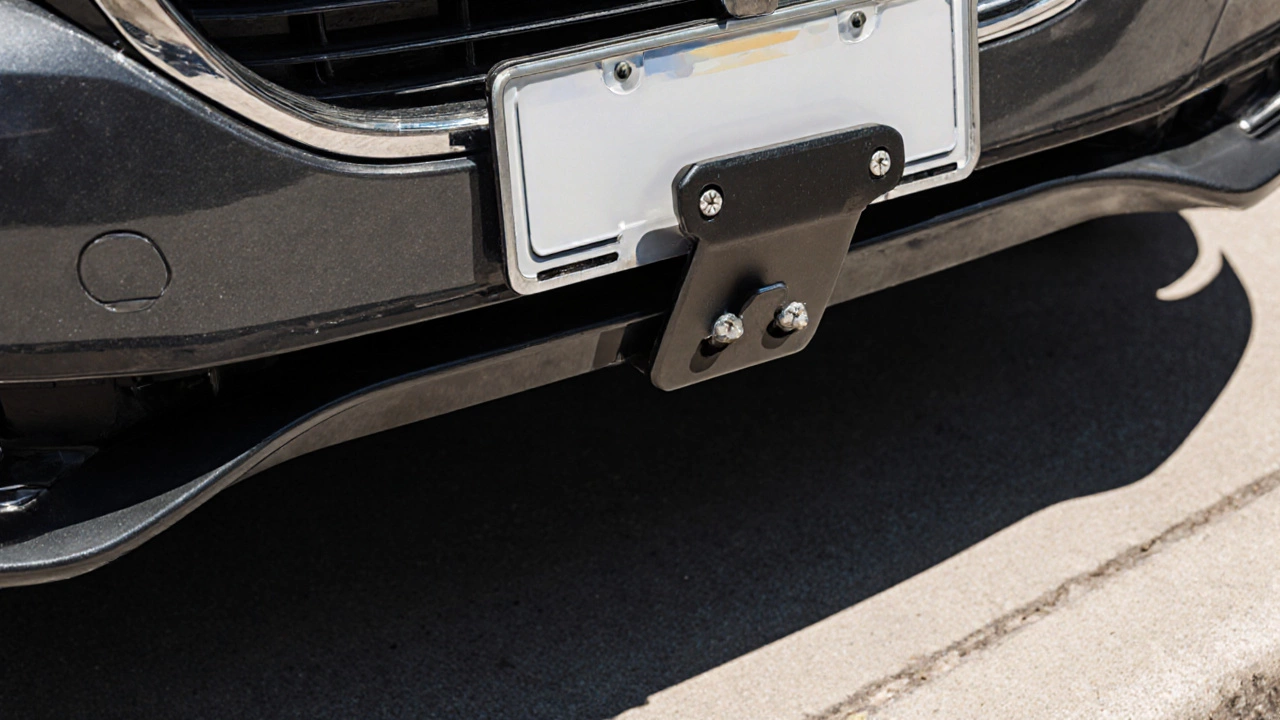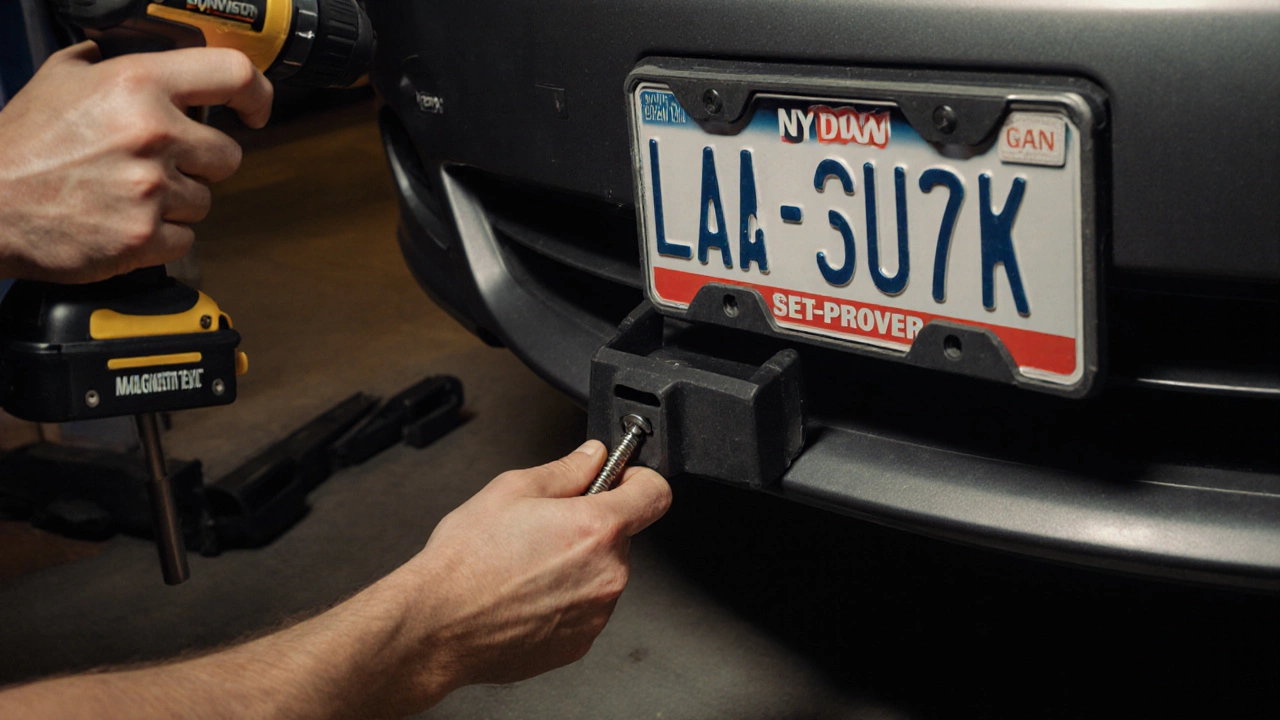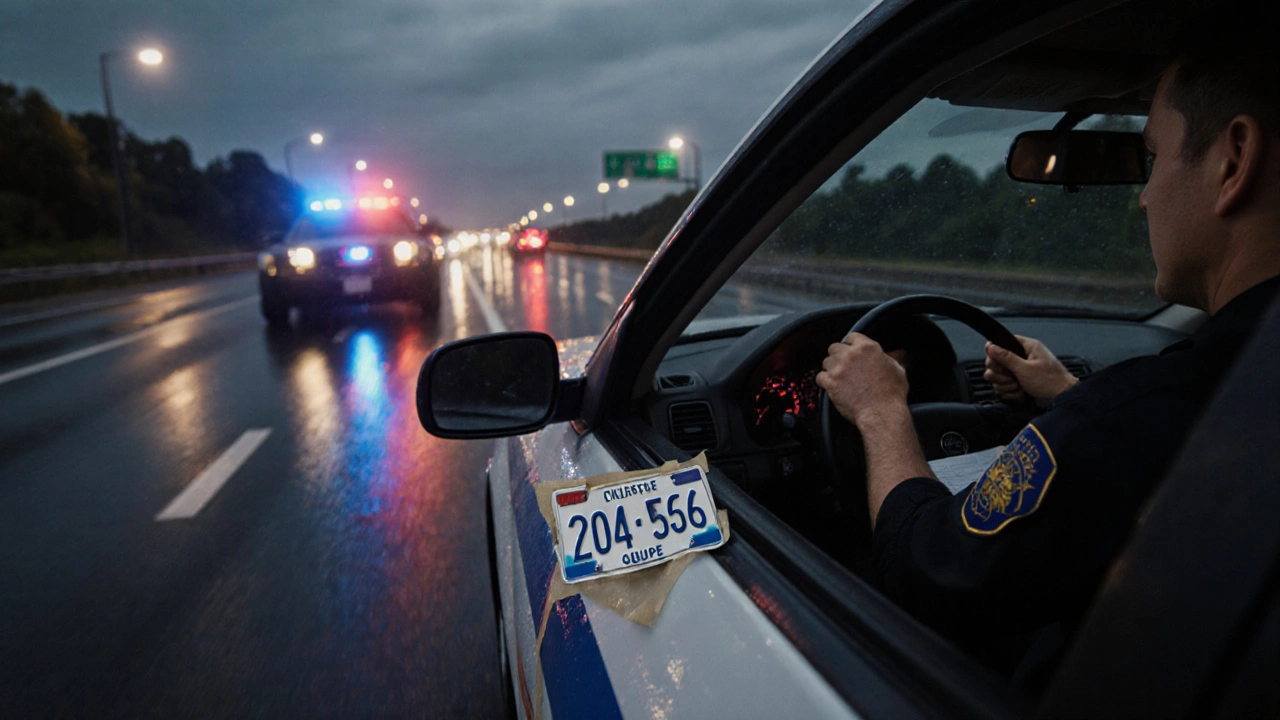New York Front License Plate Compliance Checker
Check Your License Plate Placement
New York law requires front license plates to be mounted on the exterior of your vehicle. This tool will tell you if your current mounting location is compliant.
Key Takeaways
- New York law requires a front plate to be mounted on the exterior of the vehicle, not on the dashboard.
- Using a dash‑mounted plate can trigger a $200 fine, points on your driver’s license, and higher insurance costs.
- The safest way to stay compliant is to install a proper front license plate bracket or use a magnet‑mounted bracket approved by the NY DMV.
- If you’re unsure whether your car meets the requirement, a quick visual check at the bumper will confirm compliance.
- Violations are logged as a traffic citation under the Vehicle and Traffic Law, and they can affect your registration renewal.
Imagine cruising down I‑95 and getting pulled over for something you thought was harmless: a front license plate taped to the dash. In New York, that simple mistake can cost you $200, add points to your license, and even raise your insurance premium. Below we break down exactly what the law says, why the dash is a no‑go, and how to mount the plate the right way.
front license plate is a vehicle identifier that must be displayed on both the front and rear of most motor vehicles registered in New York State. The requirement comes from the Vehicle and Traffic Law (VTL), enforced by the New York State Department of Motor Vehicles (NY DMV). Violating the law results in a traffic citation and can impact your vehicle registration status.
What New York Law Says About Front Plate Placement
Section 402 of the New York Vehicle and Traffic Law states that a front plate must be "mounted on the front of the vehicle and be clearly visible to other drivers." The wording "mounted on the front" is interpreted by the NY DMV as an exterior location-typically the front bumper or a dedicated bracket attached to the bumper.
The law does not define an exact distance from the ground, but the plate must be positioned so that it is unobstructed, readable from a reasonable distance, and not covered by any part of the vehicle’s bodywork.
Because the statute specifically references "the front of the vehicle," a plate placed inside the cabin-on the dashboard, windshield, or console-does not satisfy the legal definition.
Why the Dashboard Is Not a Legal Spot
The dashboard sits inside the vehicle’s cabin, shielded by the windshield and roof. From a law‑enforcement perspective, a front plate on the dash fails two critical tests:
- Visibility: Officers searching for a plate rely on an outward glance. An interior plate is hidden from other road users.
- Safety: A plate unsecured on the dash can become a projectile in a crash, posing a risk to the driver and passengers.
The NY DMV’s compliance guide explicitly lists "interior surfaces" as prohibited mounting locations. If you’re caught, the citation will cite VTL §402 and classify the offense as a “failure to display front license plate.”

Risks of Using a Dash‑Mounted Plate
Getting stopped for a dash‑mounted plate isn’t just about the fine. Here’s what else can happen:
- Monetary penalty: $200 for a first‑time offense, plus court costs if you contest.
- Points on your license: One point added, which can affect your driving record.
- Insurance impact: Insurers view traffic violations as risk factors, potentially raising premiums by 5‑10%.
- Registration delay: Unresolved citations can block renewal of your vehicle registration until paid.
Many drivers are surprised to learn that a seemingly minor modification can snowball into higher costs for years.
How to Mount a Front Plate Correctly
The good news is that compliance is straightforward. Follow these steps:
- Purchase a front license plate bracket that matches your vehicle make and model. Most auto parts stores carry universal brackets, but a model‑specific bracket ensures a flush fit.
- Clean the bumper area thoroughly to remove dust and grease.
- Attach the bracket using the supplied screws or bolts. For unibody cars, a rubber‑mounted bracket avoids drilling into the bumper.
- Align the plate so the numbers are horizontal, centered, and at least 4 inches above the ground.
- Secure the plate with the provided screws. Some drivers prefer a magnetic bracket-make sure it’s NY DMV‑approved, as weak magnets can detach.
If you own a classic or a vehicle with a non‑standard front end, you can apply for a waiver. The NY DMV allows exemptions for antique cars, off‑road vehicles, and certain custom builds, but you must submit a written request with photos and an inspection fee.
Quick Compliance Checklist
- Plate is on the exterior front bumper or bracket.
- Plate is fully visible, not obscured by mud, snow, or accessories.
- Screws or approved magnetic fasteners hold the plate securely.
- Plate is legible from at least 50 feet away.
- Documentation (if any) of exemption is filed with the NY DMV.
Run through this list each time you wash your car-especially after winter, when salt and snow can hide the plate.

Comparison of Common Placement Options
| Location | Legal? | Typical Fine | Notes |
|---|---|---|---|
| Front bumper (bracket) | Yes | - | Meets VTL requirements; most common. |
| Dash (interior) | No | $200 + court costs | Fails visibility test; safety hazard. |
| Windshield (magnet) | No | $200 | Often used in states without front‑plate laws; illegal in NY. |
| Rear‑only (no front) | No | $200 | Violates VTL §402; may lead to registration hold. |
| Approved exemption (antique) | Yes with waiver | Waiver fee ($40‑$50) | Requires NY DMV approval. |
What to Do If You’re Already Cited
First, don’t ignore the ticket. Paying the fine within 30 days typically prevents points from being added. If you believe the citation was issued in error-perhaps the officer missed a properly installed bracket-consider contesting it in traffic court. Bring:
- Photos of your front plate showing correct mounting.
- The original ticket and a copy of your vehicle registration.
- Any receipts for a compliant bracket installation.
The judge will compare the evidence against VTL §402. A successful challenge can result in the fine being dismissed and the point removed.
Frequently Asked Questions
Can I use a magnetic front‑plate holder in New York?
Magnetic holders are only allowed if they are specifically approved by the NY DMV. Most generic magnets do not meet the security standards, so they are considered illegal and can result in a citation.
What if my car’s bumper is damaged and I can’t mount a bracket?
You can apply for a temporary waiver while you repair the bumper. Submit a written request to the NY DMV with photos of the damage and a repair estimate. The waiver is valid for up to 30 days.
Do luxury or electric vehicles have different front‑plate rules?
No. The front‑plate requirement applies to all passenger vehicles, trucks, and SUVs regardless of make, model, or powertrain. Specialty vehicles may qualify for exemptions, but they must still be approved by the NY DMV.
Will a dash plate affect my car’s resale value?
Potential buyers often view a dash‑mounted plate as a sign of non‑compliance, which can lower the perceived value. Fixing the issue before sale is a simple way to avoid bargaining down.
How often does the NY DMV inspect front‑plate compliance?
Compliance checks occur during registration renewal, annual safety inspections, and random traffic stops. The NY DMV can also conduct targeted enforcement campaigns in high‑traffic areas.
Bottom line: a front license plate belongs on the outside of your vehicle, not on the dash. By installing a proper bracket and keeping the plate clean and visible, you stay legal, avoid fines, and keep your insurance rates steadier. If you’re ever in doubt, a quick visual check of the bumper will save you time, money, and a lot of hassle.
